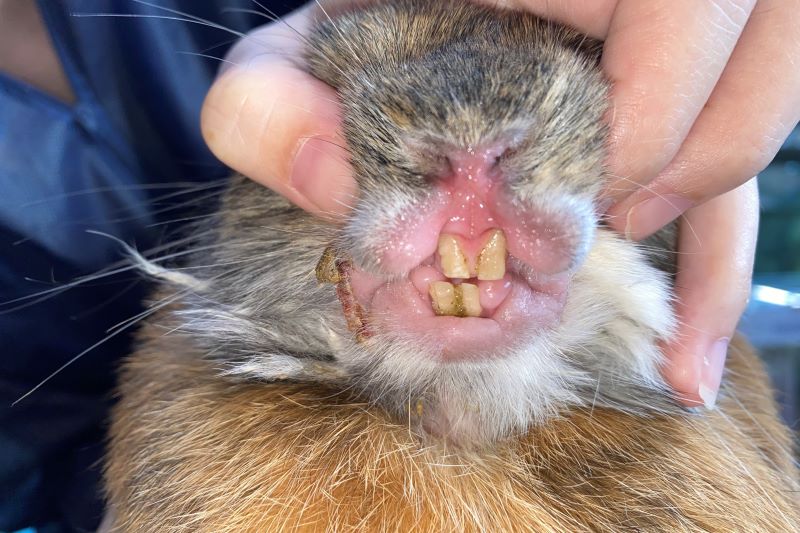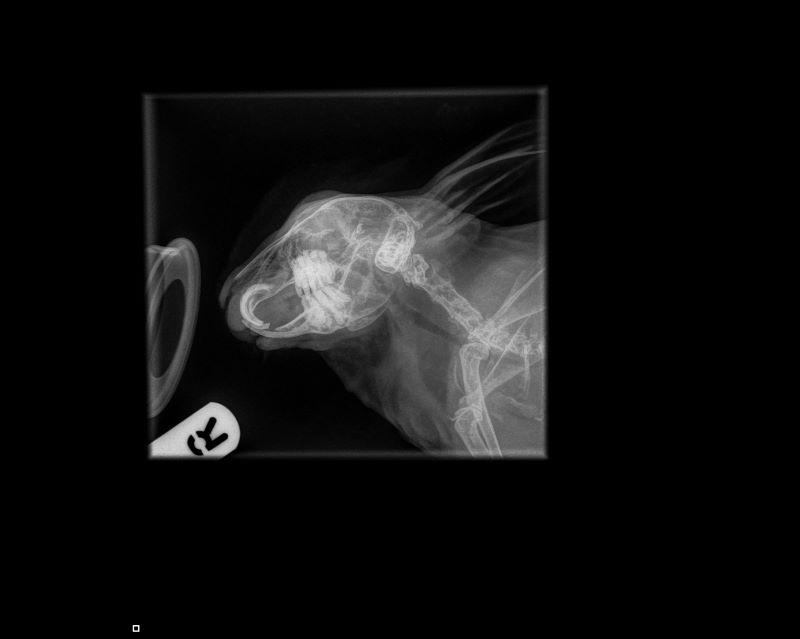New RVC VetCompass research offers insights into clinical management and welfare impacts of rabbit dental disease
A team of researchers within the VetCompass Programme at the Royal Veterinary College (RVC) studying dental disease in rabbits under primary veterinary care have identified common clinical signs for rabbits experiencing dental disease and assessed veterinary diagnostic and treatment methods. The findings can be used to improve veterinary training on rabbit medicine to increase confidence when diagnosing and treating this disease and ultimately to enhance rabbit quality of life.

Dental disease is highly prevalent in companion rabbits across the UK. While recommended diagnostic and treatment methods are well-described in literature, the methods actually used in day-to-day veterinary care by primary-care veterinarians have not been well documented. Research suggests many veterinary surgeons have lower confidence in the assessment of pain, diagnosis, and treatment of rabbits than they do for cats and dogs. Therefore, benchmarking and detailing current veterinary diagnostic and treatment methods used may help identify possible opportunities for improvement and even allow inference on the welfare implications of veterinary interventions themselves.
The study, conducted by the RVC, used a random sample of 2,219 cases of dental disease from a total study population of 161,979 rabbits. These cases diagnosed with dental disease were identified from anonymised electronic patient records within VetCompass, from rabbits attending UK primary veterinary care practices during 2019.
Data was extracted for each dental disease case from free-text clinical notes covering a variety of factors including: clinical signs related to dental disease (either reported by an owner or identified by a veterinarian); diagnostic methods for diagnosis of dental disease; tooth trimming or tooth extraction; recommendations for dietary modification in relation to the rabbit’s dental disease; referral for advanced clinical management for dental disease (including treatment within or outside of the original practice); and contribution of dental disease to death.
The main findings of the study included:
- Visual oral examination contributed to diagnosis in 2,168 rabbits (99.7% of the 2175 rabbits with diagnostic method recorded), radiography contributed to 49 (2.2%), and computed tomography (CT) scanning to seven (0.3%).
- Across the 754 rabbits (34.0%) that received tooth trimming, there were 244 (32.4%) incisor trimming events and 593 (78.6%) cheek teeth trimming events.
- Cheek teeth trimming was performed on conscious (non-sedated or non-anaesthetised) rabbits in 36 (6.1%) cases.
- Dietary modification for improvement of dental disease was recommended for 476 (21.5%) cases.
- The most frequently recorded clinical signs were reduced food intake (n=557, 25.1%), reduced faecal output (n=241, 10.9%) and ocular discharge (n=235, 10.6%), with 1,123 (50.6%) rabbits not having any clinical signs recorded.
- Of the 547 (24.7%) rabbits recorded to have died during the study period, 92 (16.8%) had dental disease reported as the primary cause of death and 188 (34.4%) had dental disease reported as a contributory factor of death.
These findings can now be used to inform improvements in initial veterinary training and professional development to boost veterinary confidence in diagnosing and treating this commonly seen disease.
Potential improvement opportunities include:
- Greater use of diagnostic imaging to assess sub-gingival tooth roots
- Always using chemical restraint during cheek tooth trimming to prevent iatrogenic injury, inadequate treatment, and stress to the rabbit
- Never using nail clippers to trim incisors
- Ensuring sufficient analgesia provision to encourage eating of fibrous food that will aid in prevention of dental disease, wearing teeth down during the early stages of dental disease, and will aid digestion to prevent any gastrointestinal co-morbidities
- Reminding owners of the importance of provision of hay (or grass) in the diet, and to never feed muesli or high sugar human foods, such as bread or breakfast cereals.
Maria Jackson, Research Assistant in Rabbit Health and Welfare, Veterinary Nurse, and Lead Author on the paper said:

“When assessing the clinical records of these 2,219 rabbits with dental disease, I was glad to see that so many owners of affected rabbits were advised to change their rabbit’s diet. Feeding lots of high-fibre hay, grass, and leafy greens is crucial in the prevention, or slowing the progression, of dental disease.
“On the other hand, I was surprised to see so few cases where radiography was used. Most, if not all, veterinary practices have radiography equipment, and it’s an invaluable tool to aid diagnosis of dental disease, planning treatment, and to show owners the extent of their rabbit’s dental disease.”
Dr Charlotte Burn, Associate Professor at the RVC, and supervisor of the study said:
“We already knew that dental disease can be painful for rabbits and can stop them being able to eat properly, but this research reinforces the importance of good veterinary care for rabbit teeth. Many rabbits find it stressful having their cheek teeth examined or trimmed using the recommended methods, but sedation and analgesia can help with this where appropriate. Having a full radiographic diagnosis, followed by tailored treatment and advice, can help improve rabbit quality of life.”
Dr Dan O’Neill, Associate Professor at the RVC, and supervisor of the study said:
“The results from the current VetCompass study fill a critical need identified by the RCVS for benchmarking data that allow practices and practitioners to compare and reflect on their own activity relative to that of their national peers. These processes of clinical audit can support hugely valuable cycles of learning and improvement on rabbit medicine and veterinary care.”
Dr Huw Golledge, Chief Executive and Scientific Director of the Universities Federation for Animal Welfare (UFAW), which helped fund this study, said:
“Understanding how veterinary professionals diagnose and treat rabbit dental disease is essential for improving rabbit welfare. This research provides invaluable insights into current practices and highlights key areas for evidence-based improvement, ultimately helping to ensure better health and welfare outcomes for pet rabbits. UFAW is proud to support studies like this that drive real-world improvements in animal welfare."
This study was partially funded by the Universities Federation for Animal Welfare (UFAW) and the RVC’s VetCompass.
Notes to Editors
The Royal Veterinary College’s Exotics referral service handles complex cases for small mammals and exotics including rabbit dental procedures. More information about this service can be found here.
Advice and factsheets from the RVC’s experts on rabbit welfare and resources for owners can be found here.
Reference
Maria A. Jackson, Dan G. O’Neill, Joanna Hedley, Dave C. Brodbelt and Charlotte C. Burn, “Dental disease in rabbits under UK primary veterinary care: Clinical management and associated welfare impacts”, Vet Record (2025).
The full paper is available from Vet Record (2025). The paper’s DOI is: 10.1002/vetr.5326
For media enquiries, please contact:
- Jasmin De Vivo jasmin.devivo@plmr.co.uk or rvc@plmr.co.uk
- Press Line: 0800 368 9520
About the RVC
- The Royal Veterinary College (RVC) is the UK's largest and longest established independent veterinary school and is a Member Institution of the University of London.
- It is one of the few veterinary schools in the world that hold accreditations from the RCVS in the UK (with associated recognition from the AVBC for Australasia, the VCI for Ireland and the SAVC for South Africa), the EAEVE in the EU, and the AVMA in the USA and Canada.
- The RVC is ranked as the top veterinary school in the world in the QS World University Rankings by subject, 2024.
- The RVC offers undergraduate and postgraduate programmes in veterinary medicine, veterinary nursing and biological sciences.
- The RVC is a research-led institution, with 88% of its research rated as internationally excellent or world class in the Research Excellence Framework 2021.
- The RVC provides animal owners and the veterinary profession with access to expert veterinary care and advice through its teaching hospitals and first opinion practices in London and Hertfordshire.
About the Universities Federation for Animal Welfare
The Universities Federation for Animal Welfare (UFAW) is an international, independent scientific and educational animal welfare charity and membership organisation. UFAW’s vision is a world where the welfare of all animals affected by humans is maximised through a scientific understanding of their needs and how to meet them.
UFAW promotes an evidence-based approach to animal welfare by funding scientific research, supporting the careers of animal welfare scientists and by disseminating animal welfare science knowledge both to experts and the wider public.
UFAW’s work relies on the support of members, subscribers, and donors. To learn more about our work, to become a member of UFAW, or to donate, please visit www.ufaw.org.uk/
Media Contact: Carly Halliday (media@ufaw.org.uk)
You may also be interested in:
-
VetCompass research shines at BSAVA Congress 2025 with 18 studies represented
This month, the BSAVA Congress 2025 will showcase an impressive line-up of eighteen VetCompass …


